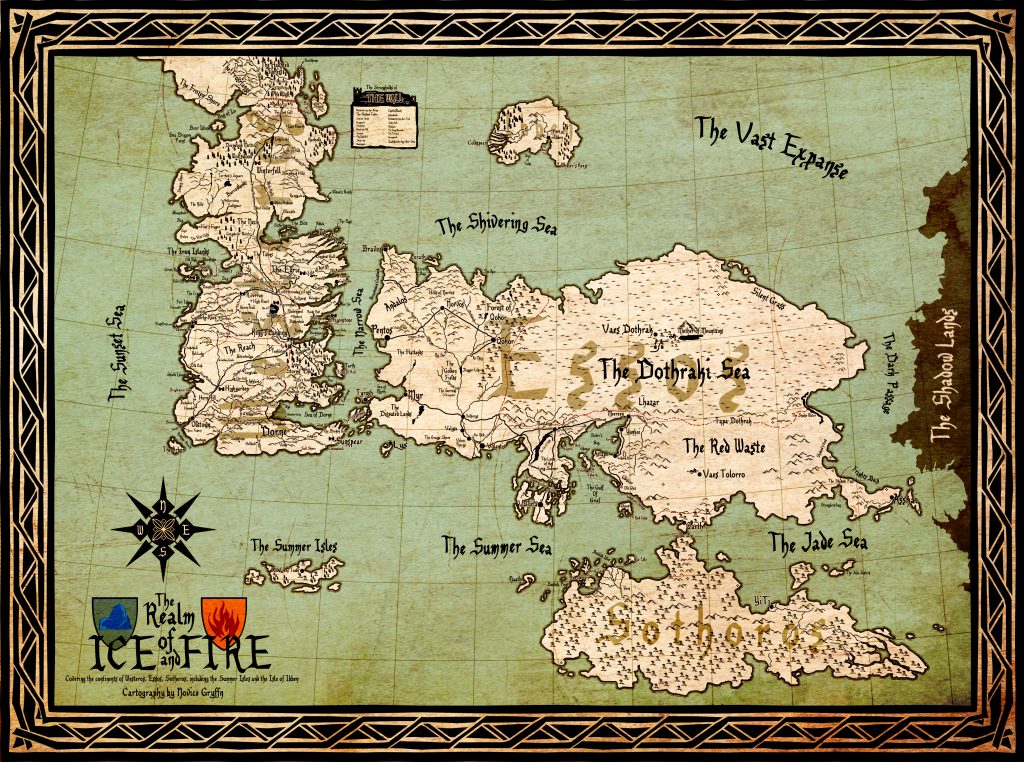Season 5 of Game of Thrones is underway and fans of the hit HBO TV series based off the best selling books by George R.R. Martin are all abuzz. As someone who has been reading the books since they first came out (and often eagerly waiting for what seems like an eternity for the next instalments in the series!) I have been avidly following the HBO series since it first premiered. I remember when the television studio announced they would be taking on the task of bringing the A Song of Ice and Fire books to life. I thought to myself: “If any television station stands a chance at doing the books justice in an ongoing series, it would be HBO.” Now of course there have been changes while adapting the series from page to screen, but overall I find most people agree that the show has done a great job capturing the world of Westeros and the myriad of characters whose stories bring us into this fantasy that somehow reminds us of our own world we live in.
Just like our own world and the history it has grown from, Westeros exists in a world filled with a diversity of cultures, languages, religions, species and environments. When watching Game of Thrones, cities like King's Landing act as backdrop where we get a glimpse into a melting pot where many of these different cultures collide. The writers, directors and their incredible team of actors work hard developing the history and cultural backgrounds of different characters. Each actor develops an accent, ways of moving and mannerisms to tell the story of the character they are portraying. As a Western Martial Artist -- and as someone who comes from a performance background -- I am always curious to see how fight directors and actors succeed or fail at bringing that authenticity into their fight scenes. When two characters from two completely different cultural backgrounds and experiences meet in combat, how do they fight? Do their movements and fighting styles help to progress the story and history they are trying to showcase through their character, or do they just bash each other around using the same methods? Even though a non-martial artist might not be able to pinpoint these specifics while watching a film, there is still a certain aspect to the story telling and character development that almost anyone can see is lost.
The Progression of the Fight Choreography in Game of Thrones
From a personal perspective it has been very interesting for me to watch how the combat choreography has changed and grown with each season of Game of Thrones. In the first season, I felt that the stage combat was pretty generic. Different races and classes of people used different weapons, but their fighting styles were all pretty much the same. The one place I felt where this was the exception in the first season was with Arya Stark's sword fighting "dancing master" Syrio Forel, played by actor Miltos Yerolemou. You can see what I mean by clicking on the link below which has compiled most of the fight scenes from the fist season of the HBO series.
When you get to Syrio's fight scenes it is -- in my opinion -- the first time you really see a difference in the fighting styles between his character and the guards of King's Landing. Milto's Yerolemou worked extensively with renowned fight choreographer William Hobbs to help really bring out the unique style and history behind Syrio Forel's water dancing style of sword fighting.
Game of Thrones: Season One Fights
As the series progressed, so did the attention to detail in the fight choreography. This was exceptionally apparent in the long anticipated fight scene from episode 8 in season 4 where Gregor Clegane "The Mountain" went up against Oberyn Martell, "The Red Viper of Dorne". Oberyn Martell was played by actor Pedro Pascal who trained intensively with a Wushu Master in L.A. in order to get the acrobatic style and flavour for his character's big fight scene. When asked about his experiences training with Master Hu before heading to Europe to film season 4 of Game of Thrones, Pedro Pascal had this to say:
“What's fun is that it's a style of fighting that hasn't been seen on the show yet, which is pretty cool. You get a lot of skillful swordplay, brutal hand-to-hand combat, really desperate, explosive fighting, and this one is kind of stylized, which I think is pretty cool to usher that in with this character. He's bringing so much Dorne with him to King's Landing, with his outfit, his whole look, his sound, his behavior. It's pretty cool.”
https://youtu.be/6Umweou6DNQ
As the actor himself had said, with his character's unique cultural background expressed through his accent, his clothing and his mannerisms it only made sense to continuing depicting his character accurately through a unique and stylized fight choreography. This is essential for helping to progress the story and making the characters and the history of this fictional world seem all the more real and believable.
Season 5 Hopes & Fight Choreography Expectations
I for one am hoping this trend in the attention to detail in Game of Thrones fight combat scenes continue. We already got a taste of Dornish fighting styles through Oberyn and with season 5 introducing us to his daughters the Sand Snakes, I hope to see more of this unique fighting style driving these characters' culture and history home. With Arya on her way to Braavos I also hope that we shall not only see more water dancing, but also unique martial styles showcase themselves through the group of Assassins known as the Faceless Men and the mysterious House of Black and White. Either way, I will be following eagerly along every Sunday night when each new episode airs.



